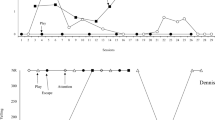Abstract
Elopement is a behavior that occurs in many children with autism spectrum disorder as well as other developmental disorders that often places them at risk of injury or death from traffic or drowning. A multiple baseline design across three targeted transitions was used in this study to evaluate the effectiveness of a differential reinforcement of incompatible behavior (DRI) intervention implemented by the child’s classroom teacher and paraeducator during the school day. The behavioral skills training (BST) model was followed to train the classroom teacher and paraprofessional staff to implement DRI to eliminate the elopement of the preschool student with ASD. The BST model of training resulted in staff quickly acquiring the data collection and DRI skills and maintaining mastery of the procedures without further training. The student’s straying and elopement behaviors were eliminated across transitions as well as during the fading of reinforcement phase. The school staff reported a positive perception on the use of the DRI intervention.


Similar content being viewed by others
References
Anderson, C., Law, J. K., Daniels, A., Rice, C., Mandell, D., Hagopian, L., & Law, P. A. (2012). Occurrence and family impact of elopement in children with autism spectrum disorders. Pediatrics, 130, 870–877.
Cooper, J. O., Heron, T. E., & Heward, W. L. (2014). Applied behavior analysis (2nd ed.). United Kingdom: Pearson Education Limited.
Gianoumis, S., Seiverling, L., & Sturmey, P. (2012). The effects of behavioral skills training on correct teacher implementation of natural language paradigm teaching skills and child behavior. Behavioral Interventions, 27, 57–74.
Homlitas, C., Rosales, R., & Candel, L. (2014). A further evaluation of behavioral skills training for implementation of the picture exchange communication system. Journal of Applied Behavior Analysis, 47(1), 198–203.
Knowles, M. (1980). The modern practice of adult education: andragogy versus pedagogy. Englewood Cliffs: Cambridge Adult Education.
Kucharczyk, S. (2013). Differential reinforcement of alternative, incompatible, or other behavior (DRA/I/O) fact sheet. Chapel Hill: The University of North Carolina, Frank Porter Graham Child Development Institute, National Professional Development Center on Autism Spectrum Disorders.
Lang, R., Rispoli, M., Machalicek, W., White, P. J., Kang, S., Pierce, N., Mulloy, A., Fragale, T., O’Reilly, M., Sigafoos, J., & Lancioni, G. (2009). Treatment of elopement in individuals with developmental disabilities: a systematic review. Research in Developmental Disabilities, 30, 670–681.
Leaf, J., Townley-Cochran, D., Taubman, M., Cihon, J., Oppenheim-Leaf, M., Kassardjian, A., Leaf, R., McEachin, J., & Pentz, T. (2015). The teaching interaction procedure and behavioral skills training for individuals diagnosed with autism spectrum disorder: a review and commentary. Review Journal of Autism and Developmental Disorders, 2(4), 402–413.
Levinson, S., Kopari, J., & Fredstrom, J. (2002). Helping kids change their behavior: the helper’s guide to the MotivAider method. Thief River Falls: Behavioral Dynamics.
Miltenberger, R. G. (2012). Behavior modification: principles and procedures. Belmont: Cengage Learning.
Murphy, G., Beadle-Brown, J., Wing, L., Gould, J., Shah, A., & Holmes, N. (2005). Chronicity of challenging behaviours in people with severe intellectual disabilities and/or autism: a total population sample. Journal of Autism and Developmental Disorders, 35, 405–418.
Pennington, R., Strange, C., Stenhoff, D., Delano, M., & Ferguson, L. (2012). Leave the running shoes at home: addressing elopement in the classroom. Beyond Behavior, 21(3), 3–7.
Perrin, C., Perrin, S., Hill, E., & DiNovi, K. (2008). Brief functional analysis and treatment of elopement in preschoolers with autism. Behavioral Interventions, 23(2), 87–95.
Piazza, C. C., Hanley, G. P., Bowman, L. G., Ruyter, J. M., Lindauer, S. E., & Saiontz, D. M. (1997). Functional analysis and treatment of elopement. Journal of Applied Behavior Analysis, 30(4), 653–672.
Sarokoff, R. A., & Sturmey, P. (2004). The effects of behavioral skills training on staff implementation of discrete-trial teaching. Journal of Applied Behavior Analysis, 37(4), 535–538.
Sterling-Turner, H. E., Watson, T. S., Wildmon, M., Watkins, C., & Little, E. (2001). Investigating the relationship between training type and treatment integrity. School Psychology Quarterly, 16, 56–67.
Ward-Horner, J., & Sturmey, P. (2012). Component analysis of behavior skills training in functional analysis. Behavioral Interventions, 27, 75–92.
Wong, C., Odom, S. L., Hume, K., Cox, A. W., Fettig, A., Kucharczyk, S., & Schultz, T. R. (2014). Evidence-based practices for children, youth, and young adults with autism spectrum disorder. Chapel Hill: The University of North Carolina, Frank Porter Graham Child Development Institute, Autism Evidence-Based Practice Review Group.
Author information
Authors and Affiliations
Contributions
JCW and EP: designed the study. PS and JCW: assisted with the data analysis and collaborated in the writing and editing of the final manuscript. EP: executed the study, analyzed the data, and wrote the results.
Corresponding author
Ethics declarations
Conflict of Interest
The authors declare that there is no conflict of interest.
Ethics Statement
Study procedures were reviewed and approved by the University of Hawaii at Manoa Institutional Review Board. Informed parental consent was received in writing prior to beginning the study.
Rights and permissions
About this article
Cite this article
Wells, J.C., Sheehey, P. & Pratt, E. Reducing Elopement in a Preschooler with Autism Using Differential Reinforcement. Adv Neurodev Disord 3, 38–44 (2019). https://doi.org/10.1007/s41252-018-0085-1
Published:
Issue Date:
DOI: https://doi.org/10.1007/s41252-018-0085-1




